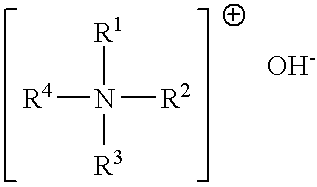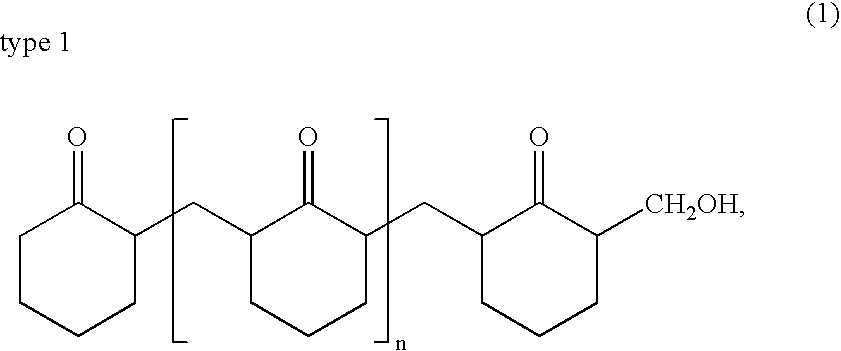Preparation of ketone-formaldehyde resins
a technology of ketone and formaldehyde, which is applied in the direction of dyeing process, synthetic resin layered products, transportation and packaging, etc., can solve the problems high softening point of resin, and disadvantage of high molecular weight, so as to reduce the amount of solvent and water used, the space-time yield is high
- Summary
- Abstract
- Description
- Claims
- Application Information
AI Technical Summary
Benefits of technology
Problems solved by technology
Method used
Image
Examples
example
[0071]The following admixture was carried out, in which cyclohexanone and paraformaldehyde were assumed to be 100% pure:
[0072]
ComponentAmountmol of componentCyclohexanone196.00g6Paraformaldehyde50.00g5Tetraethylammonium hydroxide7.5mL0.02(TEAH), 40 wt %
[0073]The resulting cyclohexanone-formaldehyde resin corresponds to the type 0.
[0074]Cyclohexanone and paraformaldehyde were initially charged in a 500 mL three-neck flask. Under nitrogen, 7.5 mL of 40 wt % TEAH solution were added in portions. Condensation was effected between 60 and 90° C. until the temperature rose no further and the pH of greater than 8 remained constant.
[0075]At this point in the condensation, the mixture was heated and the water of reaction which had formed distilled off. Afterward, the mixture was heated to 180° C. and the catalyst removed under vigorous stirring. The initially yellow to brown resins become ever lighter with progressive removal of the catalyst. After cooling, 214 g (yield: 87%) of light-colored...
PUM
| Property | Measurement | Unit |
|---|---|---|
| temperatures | aaaaa | aaaaa |
| temperatures | aaaaa | aaaaa |
| temperatures | aaaaa | aaaaa |
Abstract
Description
Claims
Application Information
 Login to View More
Login to View More - R&D
- Intellectual Property
- Life Sciences
- Materials
- Tech Scout
- Unparalleled Data Quality
- Higher Quality Content
- 60% Fewer Hallucinations
Browse by: Latest US Patents, China's latest patents, Technical Efficacy Thesaurus, Application Domain, Technology Topic, Popular Technical Reports.
© 2025 PatSnap. All rights reserved.Legal|Privacy policy|Modern Slavery Act Transparency Statement|Sitemap|About US| Contact US: help@patsnap.com



